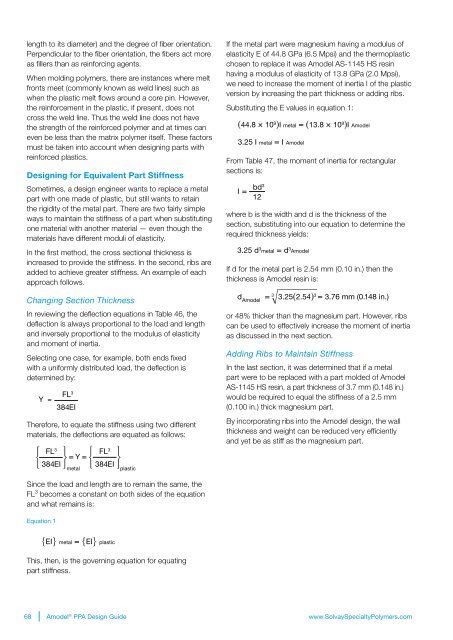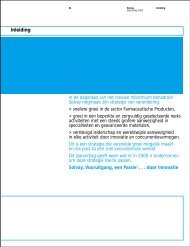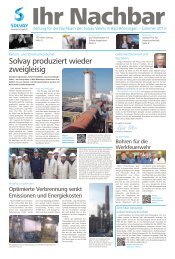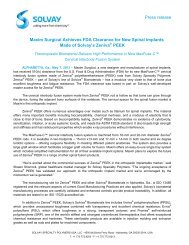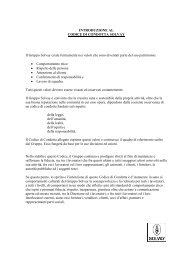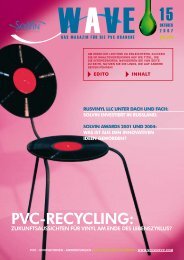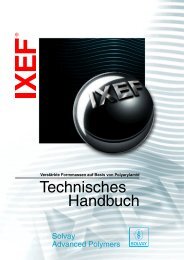Design Guide - Solvay Plastics
Design Guide - Solvay Plastics
Design Guide - Solvay Plastics
Create successful ePaper yourself
Turn your PDF publications into a flip-book with our unique Google optimized e-Paper software.
length to its diameter) and the degree of fiber orientation.<br />
Perpendicular to the fiber orientation, the fibers act more<br />
as fillers than as reinforcing agents.<br />
When molding polymers, there are instances where melt<br />
fronts meet (commonly known as weld lines) such as<br />
when the plastic melt flows around a core pin. However,<br />
the reinforcement in the plastic, if present, does not<br />
cross the weld line. Thus the weld line does not have<br />
the strength of the reinforced polymer and at times can<br />
even be less than the matrix polymer itself. These factors<br />
must be taken into account when designing parts with<br />
reinforced plastics.<br />
<strong>Design</strong>ing for Equivalent Part Stiffness<br />
Sometimes, a design engineer wants to replace a metal<br />
part with one made of plastic, but still wants to retain<br />
the rigidity of the metal part. There are two fairly simple<br />
ways to maintain the stiffness of a part when substituting<br />
one material with another material — even though the<br />
materials have different moduli of elasticity.<br />
In the first method, the cross sectional thickness is<br />
increased to provide the stiffness. In the second, ribs are<br />
added to achieve greater stiffness. An example of each<br />
approach follows.<br />
Changing Section Thickness<br />
In reviewing the deflection equations in Table 46, the<br />
deflection is always proportional to the load and length<br />
and inversely proportional to the modulus of elasticity<br />
and moment of inertia.<br />
Selecting one case, for example, both ends fixed<br />
with a uniformly distributed load, the deflection is<br />
determined by:<br />
Y<br />
FL<br />
=<br />
3<br />
384EI<br />
Therefore, to equate the stiffness using two different<br />
materials, the deflections are equated as follows:<br />
FL 3<br />
384EI<br />
= Y =<br />
metal<br />
FL 3<br />
384EI<br />
plastic<br />
If the metal part were magnesium having a modulus of<br />
elasticity E of 44.8 GPa (6.5 Mpsi) and the thermoplastic<br />
chosen to replace it was Amodel AS-1145 HS resin<br />
having a modulus of elasticity of 13.8 GPa (2.0 Mpsi),<br />
we need to increase the moment of inertia I of the plastic<br />
version by increasing the part thickness or adding ribs.<br />
Substituting the E values in equation 1:<br />
(44.8 × 10 9 )I metal = (13.8 × 10 9 )I Amodel<br />
3.25 I metal = I Amodel<br />
From Table 47, the moment of inertia for rectangular<br />
sections is:<br />
I =<br />
bd 3<br />
12<br />
where b is the width and d is the thickness of the<br />
section, substituting into our equation to determine the<br />
required thickness yields:<br />
3.25 d 3 metal = d 3 Amodel<br />
If d for the metal part is 2.54 mm (0.10 in.) then the<br />
thickness is Amodel resin is:<br />
d<br />
Amodel<br />
3<br />
= 3.25(2.54) 3 = 3.76 mm (0.148 in.)<br />
or 48% thicker than the magnesium part. However, ribs<br />
can be used to effectively increase the moment of inertia<br />
as discussed in the next section.<br />
Adding Ribs to Maintain Stiffness<br />
In the last section, it was determined that if a metal<br />
part were to be replaced with a part molded of Amodel<br />
AS-1145 HS resin, a part thickness of 3.7 mm (0.148 in.)<br />
would be required to equal the stiffness of a 2.5 mm<br />
(0.100 in.) thick magnesium part.<br />
By incorporating ribs into the Amodel design, the wall<br />
thickness and weight can be reduced very efficiently<br />
and yet be as stiff as the magnesium part.<br />
Since the load and length are to remain the same, the<br />
FL 3 becomes a constant on both sides of the equation<br />
and what remains is:<br />
Equation 1<br />
{EI} metal = {EI} plastic<br />
This, then, is the governing equation for equating<br />
part stiffness.<br />
68 Amodel ® PPA <strong>Design</strong> <strong>Guide</strong><br />
www.<strong>Solvay</strong>SpecialtyPolymers.com


